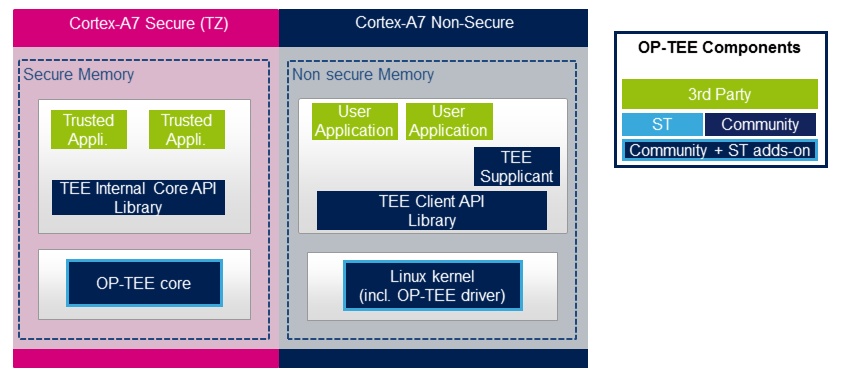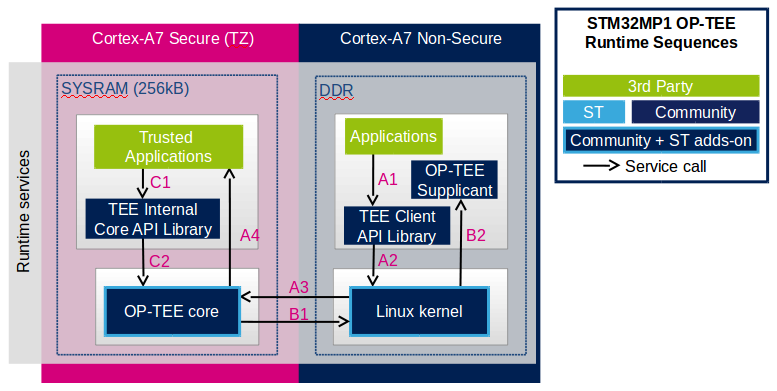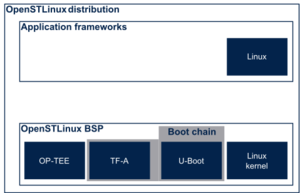1. Overview of the OP-TEE open source project[edit | edit source]
OP-TEE allows the development and integration of secure services and applications under trusted execution environments, that is execution environments isolated from the Linux® -based OS.
Description extracted from the OP-TEE website[1]:
- "OP-TEE is a Trusted Execution Environment (TEE) designed as companion to a nonsecure Linux kernel running on Arm Cortex-A cores using the TrustZone technology. OP-TEE implements TEE Internal Core API v1.1.x which is the API exposed to Trusted Applications and the TEE Client API v1.0, which is the API describing how to communicate with a TEE. Those APIs are defined in the GlobalPlatform API specifications."
OP-TEE is delivered under a BSD style license and can run secure (trusted) applications, named TAs, without restriction on their licensing model.
The OP-TEE project is maintained by the Linaro Security Working Group.
GlobalPlatform Device TEE specifications (TEE Client API, TEE Internal Core API and few more) are available on the GlobalPlatform website[6].
2. Architecture[edit | edit source]
The OP-TEE project includes several secure and nonsecure embedded components, as well as some tools for development and debugging purposes.
The figure below shows the main OP-TEE embedded components, namely the OP-TEE core and trusted application standard libraries on the secure side, and the Client API library, the OP-TEE supplicant daemon, and the OP-TEE Linux kernel driver on the nonsecure side.

OP-TEE core, on STM32 MPU devices, executes at Cortex-A secure privileged state/level. On Armv8+A platforms, OP-TEE executes at S-EL1, based on the secure monitor firmware (running at EL3) implemented by TF-A/BL31. On Armv7-A 32bit architectures, OP-TEE core embeds its own secure monitor. Refer to TF-A Architecture for more information.
2.1. OP-TEE core[edit | edit source]
The main OP-TEE component is the OP-TEE core. The OP-TEE core execution is done in Arm® Cortex®-A secure state while the nonsecure world (likely a Linux based OS) execution is done in the nonsecure state of the processor. The OP-TEE core executes in secure privileged (kernel) mode, while trusted applications are executed in secure user mode.
In OpenSTLinux distribution, OP-TEE core image is part of the boot firmware images that include the Arm Secure Monitor firmware, the U-Boot loader image and its Device Tee Binary image.
One of the secure services implemented in OP-TEE is support of signed trusted applications, authenticated (possibly decrypted) when loaded in secure world. Trusted applications binary images can be either stored in one of the Linux OS file systems or protected by the OP-TEE secure persistent storage or embedded in the OP-TEE core boot image. Means of authentication and update of the trusted applications images depend on their storage location.
In order to embed OP-TEE’s secure services, OP-TEE core needs to execute in a secure memory. On devices with secure encrypted external memory, the OP-TEE core runs as a monolithic image in the secure memory area of the external RAM. On devices where the external memory cannot be encrypted, OP-TEE needs to be executed in a much smaller secure memory. OP-TEE core can run in paging-on-demand configuration: a small memory resident agent is loaded in the secure memory and can securely page-in/page-out data from/to the nonsecure (or less secure) external memory. This process implies hashing and authenticated ciphering of the secure content.
For platforms that do not need secure services, OpenSTLinux proposes an OP-TEE configuration profile named OP-TEE system services profile. With this profile, OP-TEE core does not strictly need to run in a secure memory but for platform integrity, OpenSTLinux enables RAM access firewalls and can disable RAM encryption if required.
For platforms that require secure services, OpenSTLinux proposes an OP-TEE configuration profile named OP-TEE secure and system services profile.
For more details on STM32MP profiles for OP-TEE, see the configuration profiles article.
OP-TEE core source files can be found from optee_os repository [2].
2.2. OP-TEE trusted libraries[edit | edit source]
OP-TEE embeds utility libraries for trusted application development including the GlobaPlatform Device TEE Internal Core API Library, which provides the standard services a trusted application can expect from the TEE. OP-TEE supports the loading of static and dynamic libraries in the TEE.
The OP-TEE standard trusted application libraries source files can be found in the optee_os repository[2].
2.3. TEE Linux driver[edit | edit source]
The OP-TEE Linux driver is part of the Linux kernel since release 4.12.
The OP-TEE Linux driver is enabled via the CONFIG_OPTEE configuration directive through the usual Linux kernel configuration means. The driver can be probed thanks to a device tree node.
2.4. TEE Client API[edit | edit source]
The OP-TEE project embeds an implementation of the GlobaPlatform Device TEE Client API specification for Linux based OS. This TEE Client API specification is partly implemented as a userland library and partly as a Linux kernel OP-TEE driver. The API allows userland clients to invoke trusted applications and the OP-TEE core services exported to nonsecure world with a standard API.
The OP-TEE Client API library source files can be found in the optee_client repository[3].
2.5. TEE supplicant[edit | edit source]
The OP-TEE core can rely on nonsecure remote services. OP-TEE embeds an implementation of a nonsecure userland supplicant, that can be invoked by the OP-TEE core through the OP-TEE Linux kernel driver. An example of such service is the access to a nonvolatile media device that is controlled in the nonsecure world.
The OP-TEE supplicant source files can be found in the optee_client repository[3].
2.6. Host tools[edit | edit source]
The OP-TEE optee_os component, once built, generates a so-called Trusted Application Development Kit to ease the development and integration of trusted applications on a target system. The Trusted Application Development Kit includes the libraries, with their header files and makefile scripts, that allow the generation of signed trusted applications from their respective source files.
Optee_os package also provides a tool to analyse call stack backtraces in case of trusted application and/or OP-TEE core crash. Refer to script symbolize.py in optee_os source tree[2].
3. Booting with OP-TEE[edit | edit source]
The OP-TEE core is a secure firmware. It must be booted prior to the nonsecure world on Arm Cortex-A core(s). The secure bootloader must therefore load the OP-TEE core images in memory and run its initialization prior to executing the first booted nonsecure image.
Refer to the target system boot sequences for more details.
4. Invoking the OP-TEE services from Linux based OS[edit | edit source]
Once the Linux kernel is booted, the OP-TEE core is already initialized and ready to serve.
The figure below shows the main run time sequences in which the OP-TEE can be involved.

Sequence A: a nonsecure application invokes a service from a trusted application.
- The nonsecure application calls the TEE Client API library (A1), which in turns invokes (A2) the Linux kernel OP-TEE driver. The OP-TEE driver invokes the secure world (A3) and reaches the OP-TEE core. The last OP-TEE core transfers the request (A4) to the target trusted application. Once the trusted application has completed the request, the system branches back to the calling application with the request status.
- If an invoked trusted application is not yet loaded into the TEE, the OP-TEE core loads it by calling remote services through the nonsecure TEE supplicant as described in sequence B below.
- In addition, any invocation of the TEE from the nonsecure world must go through the Linux kernel OP-TEE driver.
Sequence B: the OP-TEE core must invoke a nonsecure remote service.
- The OP-TEE core invokes (B1) the Linux kernel OP-TEE driver which in turns notifies the TEE supplicant daemon (B2) for a request. Once the supplicant has completed the request, the system branches back to the OP-TEE core with the request status.
Sequence C: a trusted application invokes an OP-TEE core service.
- Most of the services defined by the GlobaPlatform Device TEE Internal Core API must be executed in OP-TEE core privileged mode. The trusted application calls the corresponding service from the TEE Internal Core API library (C1), which issues a system call (C2) to the OP-TEE core. Once the core has completed the request, the system branches back to the calling trusted application with the request status.
5. Experiencing OP-TEE on a target[edit | edit source]
First make sure your setup includes OP-TEE in the boot sequence. If the OP-TEE core console traces are enabled, it's possible to see the OP-TEE banner after secure bootloader traces and before nonsecure bootloader traces. The OP-TEE core banner looks like this:
I/TC: OP-TEE version: <some-reference-version-info> #1 Mon Jun 25 08:59:21 UTC 2018 arm
I/TC: Initialized
The Linux kernel boot traces also show the successful probing of the OP-TEE Linux kernel driver:
optee: probing for conduit method from DT.
optee: initialized driver
The OP-TEE nonsecure components are stored in the file system:
- By default the TEE supplicant is installed at /usr/bin/tee-supplicant.
- By default, the TEE Client API library is installed at /usr/lib/teec.so.
- By default the TEE regression test tool is installed at /usr/bin/xtest.
In the default OP-TEE configuration, trusted applications are stored in the nonsecure filesystem at /lib/optee_armtz/*.ta.
OP-TEE provides means to protect the trusted application binary images from corruption as image signature or installation in the OP-TEE secure storage. In any case, it is likely that OP-TEE core needs to invoke a nonsecure service to retrieve the trusted application(s) from some nonsecure file system data in order to load trusted application(s) in the TEE. This service requires the availability of the OP-TEE supplicant.
Therefore, once the nonsecure OS has booted, it must launch the OP-TEE supplicant as a background daemon. Use the following shell command to start the OP-TEE supplicant from a booted Linux system:
sh> tee-supplicant &
The OP-TEE package comes with some examples and regression tests. Use the following embedded shell command to run the regression tests:
sh> xtest
or to run only selective tests:
sh> xtest 1002 # Invokes some OP-TEE internal core services
sh> xtest 1004 # Invokes a trusted application loaded from the nonsecure filesystem
6. References[edit | edit source]
